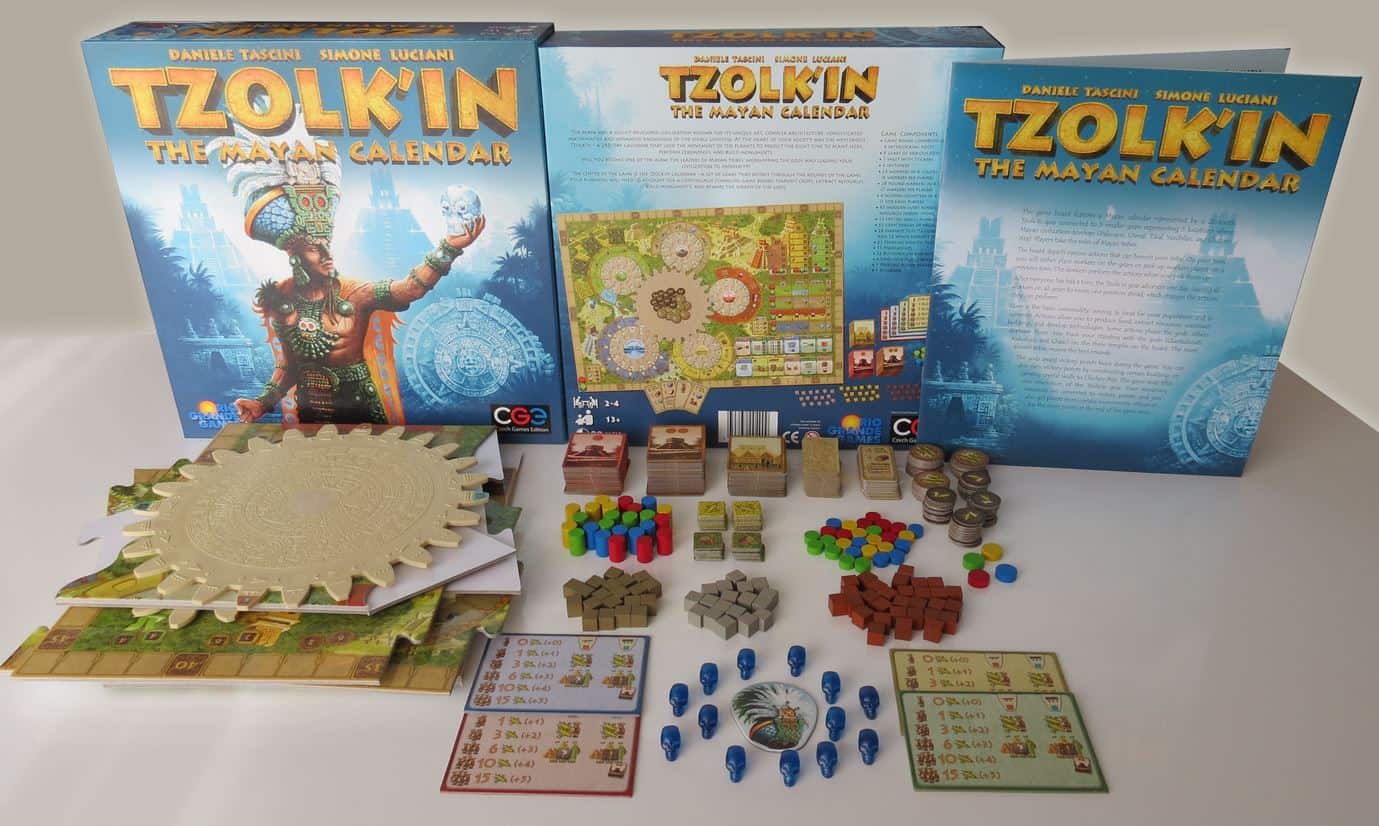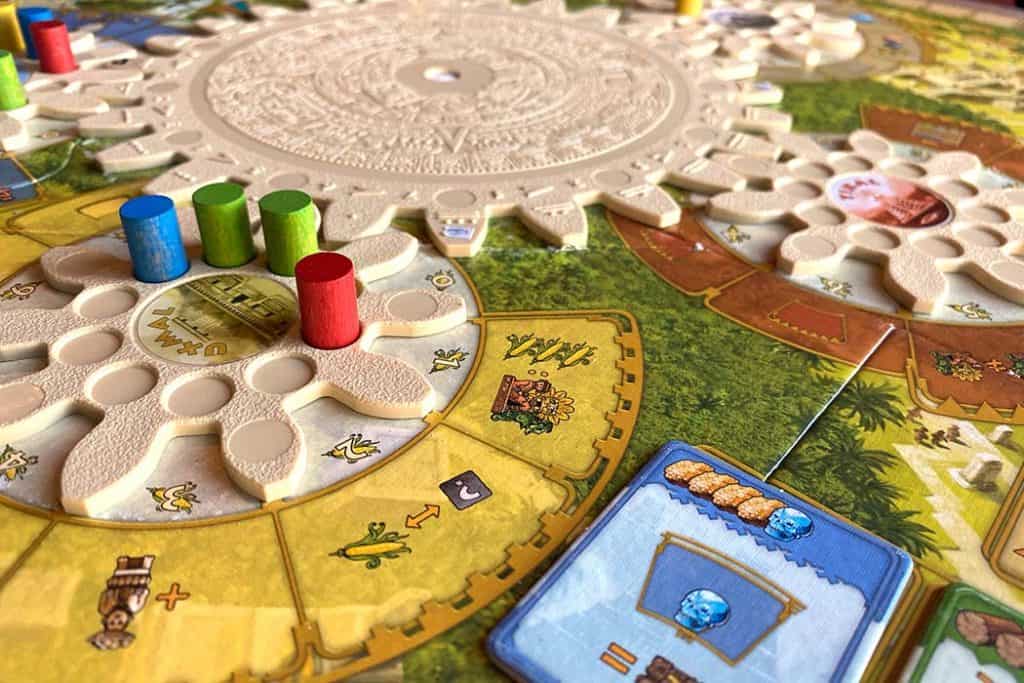Tzolk’in: The Mayan Calendar is renowned for its unique and innovative mechanic of using interlocking gear wheels as the game board. These gears represent the Tzolk’in calendar and rotate during gameplay, influencing various actions and events as they turn.
In Tzolk’in, players take on the roles of Mayan tribes, striving to gather resources, develop their civilization, and advance along multiple tracks of progress. The rotating gears create a dynamic gameplay experience as players must carefully time their actions to maximize their efficiency and score points.
The game combines strategy and resource management, making it a challenging and engaging experience for players who enjoy complex Euro-style board games. Tzolk’in has received praise for its thematic integration of the Mayan calendar and its clever use of the rotating gear mechanism, making it a favorite among board game enthusiasts.
What’s included in Tzolk’in

- Central Board: This board consists of five interlocking gear wheels representing the Mayan calendar. The gears rotate during the game, influencing the actions and rewards available to players.
- Worker Discs: Each player has a set of colored worker discs, representing their workforce.
- Resource Tokens: Resources come in four types – wood, stone, gold, and corn. These tokens are used for various actions and to feed your workers.
- Building Tiles: These represent buildings that can be constructed during the game.
- Advancement Tiles: These tiles offer various bonuses and objectives that players can pursue.
- Starting Tiles: Each player starts with a different starting building and resources.
- Victory Point Markers: These are used to track players’ victory points.
- Player Boards: These boards help players organize their buildings, advancements, and resources.
How to play Tzolk’in

The goal of Tzolk’in is to accumulate the most victory points by the end of the game. Points can be earned through various actions, advancements, and by developing your civilization.
Setup
- Assemble the central board with the five gears and place it in the center of the table.
- Give each player their chosen color of worker discs, a starting building tile, and resources according to their chosen color (usually 3 wood and 2 corn).
- Place the resource tokens near the central board.
- Shuffle the building tiles and advancement tiles separately and create face-down stacks for each.
- Place the victory point markers near the board.
- Determine the number of rounds the game will last (usually 26 rounds for a 4-player game).
- Randomly select the starting player.
Rules for Tzolk’in
Tzolk’in is played over several rounds, each consisting of multiple phases:
- Rotate the Gears: At the start of each round, the central gears rotate one space clockwise. This changes the available actions and their costs for that round. Workers on the gears advance as the gears turn.
- Place or Retrieve Workers: On your turn, you can either place one or more workers on the gears or retrieve one or more workers from the gears. Placing workers allows you to take the actions associated with the gears they occupy.
- Take Actions: When you place workers on a gear, you must pay the cost indicated by the gear’s current position on the calendar. Actions include gathering resources, constructing buildings, advancing on various tracks, or obtaining advancements. The cost decreases as the gears move forward.
- Feed Your Workers: At the end of each round, players must pay one corn per worker on the board to feed them. If you can’t afford to feed your workers, you lose victory points.
- Scoring and Advancements: Throughout the game, players can earn victory points by building buildings, advancing on tracks, and completing specific tasks on advancement tiles.
- Game End: The game typically ends after a set number of rounds. Players calculate their final scores, including points from buildings, tracks, and advancements. The player with the most victory points wins.
Worker Placement: The heart of Tzolk’in’s gameplay is the worker placement mechanic. Placing a worker on a gear action space allows you to take that action when the gear rotates. The longer you leave a worker on a gear, the more powerful the action becomes as it moves around the calendar. This creates a delicate balance between when to place workers and when to retrieve them.
Actions: Here are the main actions you can take on the gears:
- Harvest (Corn): Gain corn, the game’s primary resource.
- Wood, Stone, Gold, or Crystal: Gain one of these resources.
- Buildings: Pay resources to construct a building from your hand. Buildings provide ongoing benefits and victory points.
- Monuments: Pay resources to construct monuments. These offer significant end-game points and unique abilities.
- Advancements: Spend corn to acquire advancement tiles, which provide immediate bonuses and long-term goals.
- Chichen Itza: Place a worker here to score points based on the number of advancements you’ve collected.
- Temples: Spend resources to advance your workers on the temple tracks. Advancement on these tracks can yield powerful bonuses.
End of Game: When the last round is completed, players calculate their final scores:
- Count victory points from buildings, advancements, monuments, and the Chichen Itza.
- Deduct points for any unpaid corn used to feed workers.
- The player with the most points wins. In case of a tie, the player with the most resources remaining breaks the tie.
For the official rules, see the link below:
Strategies for the game
- Long-term Planning: Tzolk’in rewards players who think ahead. Try to anticipate the future positions of the gear wheels and plan your worker placements accordingly. Consider which actions will be most valuable in the coming rounds and position your workers to take advantage of them.
- Resource Management: Managing your resources efficiently is crucial. Corn is needed to feed your workers at the end of each round, so ensure you always have enough. Balance your resource income with your spending on buildings and advancements.
- Balanced Approach: While specialization can be powerful, don’t focus on a single strategy to the exclusion of others. A well-rounded approach that includes some resource gathering, building construction, track advancement, and advancement tiles is often a winning strategy.
- Buildings and Monuments: Buildings provide ongoing benefits and victory points, so aim to construct them early and consistently throughout the game. Monuments offer substantial end-game points and unique abilities, so don’t overlook them.
- Advancements: Advancement tiles can provide significant advantages. Look for advancements that complement your overall strategy or offer immediate benefits. Also, consider advancing on the temple tracks to unlock even more powerful advancements.
- Chichen Itza: The Chichen Itza gear can provide a substantial number of points if you’ve collected many advancements. Prioritize advancing on this gear if you’re pursuing an advancement-heavy strategy.
- Temples: Advancing your workers on the temple tracks can yield valuable bonuses. It’s particularly important to reach the top of the blue temple track to receive substantial corn income, which can help with feeding your workers.
- Scoring Opportunities: Keep an eye on the various ways to score points in the game. This includes not only buildings, monuments, and advancements but also the corn track and the temple tracks. Try to maximize your points in multiple areas.
- Tribes and Prophecies: If you’re playing with the Tribes & Prophecies expansion, use your unique tribe abilities to your advantage. Adapt your strategy based on your tribe’s strengths and objectives. Also, keep an eye on the prophecy tiles for additional scoring opportunities.
- Flexibility: Be prepared to adapt your strategy based on your opponents’ actions and the changing game state. Sometimes, it’s necessary to pivot and pursue different opportunities if your initial plan isn’t working out.
- Timing: Consider the timing of your actions. For example, if you see an opponent about to take an action you want, try to beat them to it by placing your workers strategically on the gears.
- Dice of Fate: If you’re playing with the Dice of Fate expansion, be prepared for the randomness introduced by the dice. Use these dice strategically to your advantage when possible, but also have backup plans in case your rolls don’t go as planned.